The importance of being findable
This blog post is for everyone in any English department that’s experiencing falling enrollments.
For most of my career, I didn’t think too much about where my students came from. I turned in my course request and maybe I wrote up a course description for a newsletter, but mostly, I just trusted that students would show up in my class.
And that’s the problem, really. We can’t just trust that they’re going to show up anymore.
Now, we have to ensure that what we offer is easily “findable.”

I happened to find this Ball State Advising Handbook online. It’s brand new. My fellow DUSs at ADE took a good hard look at this handbook, which will soon be in the hot little hands (or digitally in front of the eyeballs) of incoming students.
Scroll to p. 12. See the long list of majors.
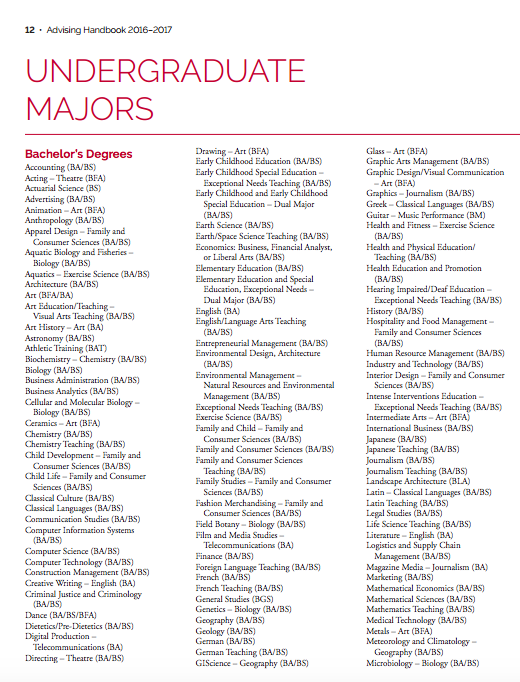
Imagine a student who is looking at this long list and who feels pressured to declare a major. “English” is in the second column, but our four specific concentrations within English are also listed, including Creative Writing, which is very popular, along with Literature, Rhetoric and Writing, etc.
The visibility and findability of these concentrations in this list allows us to compete with other storytelling and communication related majors whose names suggest the career that follows, such as Journalism and TCOM and Marketing, etc.
However, scroll to p. 14, “Selected majors by interest area.”
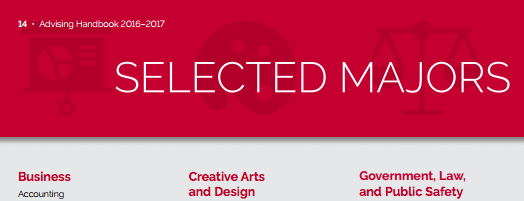

The folks in advising have very kindly tried to take that unwieldy list of 190 majors and group them into six sections: Business, Creative Arts and Design, Government, Law, and Public Safety, Health Care and Human Services, Sports and Recreation, and Technology.
Please note that English is not included in any of these categories.
Probably this is just an honest mistake, and I need to write to Laura Helms, the very very nice and hardworking Executive Director of Academic Services and Associate Dean of University College and ask if they can add English to at least one of those lists in the 2017 catalog. But that doesn’t help me with the class of 2020.
The editors of this handbook know that students are thinking about the bridge between major and job/career, and they’re definitely trying to help. But for whatever reason, English did not come to mind when they were “categorizing” majors. Partly, that’s because English doesn’t want to be categorized. We believe that our students can do ANY of those things. But the editors will probably not let me put “English” into each category, and I’ll have to pick one, and I will feel both victorious (Yay! The first-years can see us!) and I will feel like I’ve capitulated to a kind of niche marketing that I don’t really believe in. Idealism. Pragmatism. This is the life of an English department administrator.
Scroll to p. 16. Note that all of our minors are on this page. Yay!
Recruiting students in the core/gen-ed classes
Scroll to p. 18, the Core Curriculum. Study how my department has positioned itself here, because this is really, really important.
We spent a lot of time at ADE talking about the importance of general education classes. Some students come to college knowing they want to major in English, but many more find us because they “have to take” a gen-ed course and discover that they love it.
Now, for a long time, college students were required to take a literature class to graduate, but this is no longer the case.
Here are the classes every single student at Ball State must take:
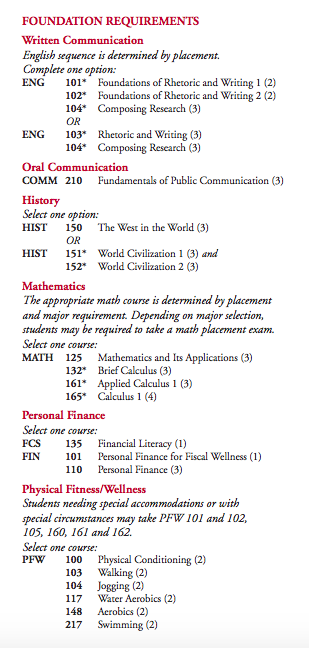 Know this: every department believes that all college students should be required to take one of their classes.
Know this: every department believes that all college students should be required to take one of their classes.
If your department offers a foundational class, as mine does, you have the opportunity to touch every single student, which is a privilege. Offering a required class means you don’t have to recruit students. They will show up. In droves.
These days, instead of requiring literature classes, most colleges include them in a menu, and my God, that menu matters so much. When your courses are menu-ized, you’re forced to think in terms of recruitment and “selling” and curb appeal.
Consider this example from DePaul University, where the gen-ed menu includes Arts and Literature. Scroll down this list. First, any course at the end of that list, such as Women’s Studies, is at a disadvantage. Second, Digital Cinema courses are in this menu, and it’s hard for traditional liberal arts majors to compete with those courses for the attention of millennial college students.
Tier 1 requirement:
The number of options in menu matter, as do the titles of those courses.
At Tier 1, our two classes compete with about 20 total.
Students are using the title alone to make a decision about which class on the menu to take.
Which of these titles will resonate?
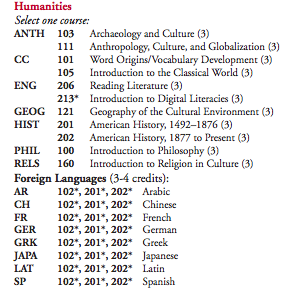
Would you be surprised that our Intro to Digital Literacies class always fills quickly? Of course not.
Our “Reading Literature” course does well, but fills a little more slowly. It would probably fill more quickly if the actual topic of each section was more apparent.
We offer about three sections a term, maybe one on Narratives of Resistance, one on Dystopian Literature, one on Road Novels. The topics are different depending on who is teaching. But what students will see in the system they use to sign up for classes is “Reading Literature.” This is what they’ll see on Banner.
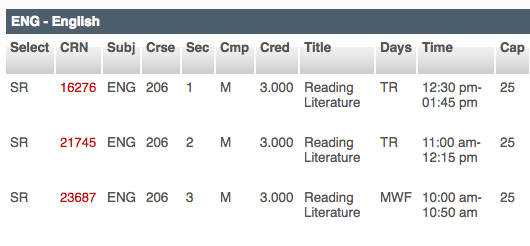
For various technological reasons, we can’t put the actual topics into this system.
We can put the those sexy, specific titles and course descriptions on our website and blog, we can make posters, etc., but it’s so hard especially at a big school like Ball State to make our topics findable by the student who is searching for a class to take.
It’s like running a really good restaurant in a city that’s hosting a big convention and not being able to let the people at the convention know that you’re just a few blocks away. Instead, all the convention go-ers eats dinner at the first restaurant they see.
Would someone invent the Yelp for cool college courses? Thanks.
Tier 2 requirement:
It’s at the next menu, Tier 2, that our department had to really think strategically about what to offer, because we’re in a much bigger menu (about 70 courses to choose from) and therefore the competition is much more fierce. We’re no longer competing with just the humanities courses anymore. We’re competing in a category called “Fine Arts, Design, and Humanities.”
If you scroll to p. 20 of the handbook, you’ll see that this is where we titled our courses much more specifically.
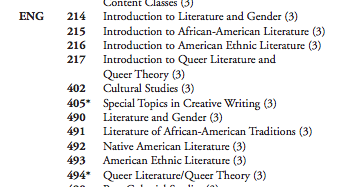
Our thinking was that we might attract students via our “Intro to [identity]” courses, and then say to those students, Hey, you can take the 400-level version of this course and then encourage them to add the major or the minor.
The importance of course descriptions
People in the English department create fascinating courses that require an explanation.
For example, what does “Narratives of Resistance” mean? Read the awesome description:
We will use the course to examine how novels, poetry, and plays have been used to challenge ideas of justice in society to create change in the system. We will read Luiz Valdez’s Zoot Suit, Mario Puzo’s The Godfather, Barbara Shoup’s American Tune, Ruth Ozeki’s All Over Creation, Claudia Rankine’s Citizen, Gary Shteyngart’s Super Sad True Love Story, in addition to a few shorter essays, stories, and episodes of Sam Esmail’s Mr. Robot. Evaluation will be based on quizzes, two midterm tests, two short papers, and a final exam.
Aha! You get to read some very good and important books AND watch one of my favorite shows, Mr. Robot. SOLD!
But what’s going to happen (through no fault of the instructor or me or anyone else) is that most students will show up the first day and only learn then that they get to read Claudia Rankine’s Citizen and watch Mr. Robot.
Note that pp. 26-31 of the advising handbook are nothing but course descriptions of the foundational classes.
Note that that the handbook doesn’t include course descriptions of any of the other classes in the core. Because that would make this document incredibly unwieldy and students probably wouldn’t read them anyway. The title of the course alone must attract and inform. And sometimes, that’s just not possible.
You’re thinking: Why not call ENG 206 Social Justice Lit?
Because we can’t promise that we’ll always offer it with that topic. Even the instructor might not want to do it time and time again.
Why not create ENG 206 Social Justice Lit, 207 Dystopian Lit, 208 Road Lit, 209 Southern Lit, etc.
Because there are not enough numbers to contain all the cool things we could teach.
I have more to say about this topic of findability, but for now, I’ll stop. Suffice it to say that it’s really important for English departments to take out their own eyeballs and look at everything with a student’s eyeballs.
We can offer the most interesting classes in the world, but if students can’t find them, no one will take them.
Higher Ed